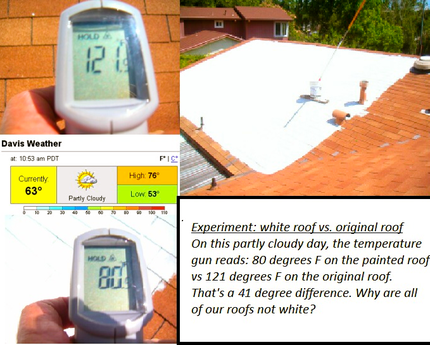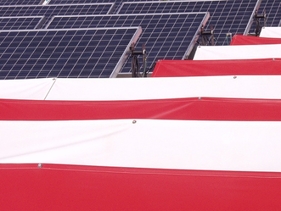
It seems logical that a white roof reflects more sun than a traditional dark roof, but does it actually save you money, and is it better for the environment? To help us find out, Talbott Solar's Dean Newberry volunteered a section of his roof for our "white roof paint" experiment.
Hypothesis: Painting roofs white will reflect off a large portion of sunlight, therefore keeping buildings cooler, save money in peak summer seasons, and will be a cheaper environmentally-friendly alternative to solar.
Experiment: Tools necessary for this project were a white roof paint, a retractable roller, and a temperature gun. A temperature gun, shown in Figure 11, is a hand held temperature reading device that shoots out a light beam that records surface temperatures. Referencing the "Davis Weather" picture, it was 63 degrees Fahrenheit (17.2 degrees Celsius) and partly cloudy on the day that the test was administered. Taking the mild climate into account, it was shocking to see that the roof's surface temperature was over 120 degrees Fahrenheit (48 degrees Celsius), as compared to a much more agreeable 80 degrees Fahrenheit (26 degrees Celsius) on the white roof.
Analysis: According a CNN reporter Vincent Valk, a promoter of painting ones roof white states: "If 80 percent of the roofs in urban areas in the tropical and temperate climate zones were painted white (or some other "cool" color, which reflects non-visible light), it would offset 24 billion metric tons worth of carbon dioxide emissions. This is the equivalent of our 300 million cars, or of 500 medium-sized coal power plants" (Valk, 2011, Why we should all paint our roofs white).
David Malakoff, writer for Guardian Environment Network throws Valk’s ideas out the door. He states that while white roofs may save some energy savings, it may cause unintentional environmental harm. A study conducted by the National Center for Atmospheric Research showed that by painting a roof white, reflective light to bounces off the roof and back into the sky. This causes a reduction in cloudiness and induces more sunlight to heat the earth. If everyone was to paint his/her roof white, this too could offset the natural warming and cooling processes of our earth.
Conclusion: Since both sides have strong arguments, further research must be done to determine to go white, or original. Putting that aside, Professor of civil and environmental engineering at Stanford, Mark Jacobson, gives an “ Option C” to those debating the issue. He remarks: “The better thing to do is to put a solar panel on the roof because that not only cools the house by absorbing the sunlight to make electricity. It also offsets fossil fuel generation at power plants" (Green Prophet, 2011).
The decision lies in your hands--to paint, or not to paint....or to save a risk, invest in a PV system.
Click on the blue lines below to be forwarded to helpful links:
_
_
Hypothesis: Painting roofs white will reflect off a large portion of sunlight, therefore keeping buildings cooler, save money in peak summer seasons, and will be a cheaper environmentally-friendly alternative to solar.
Experiment: Tools necessary for this project were a white roof paint, a retractable roller, and a temperature gun. A temperature gun, shown in Figure 11, is a hand held temperature reading device that shoots out a light beam that records surface temperatures. Referencing the "Davis Weather" picture, it was 63 degrees Fahrenheit (17.2 degrees Celsius) and partly cloudy on the day that the test was administered. Taking the mild climate into account, it was shocking to see that the roof's surface temperature was over 120 degrees Fahrenheit (48 degrees Celsius), as compared to a much more agreeable 80 degrees Fahrenheit (26 degrees Celsius) on the white roof.
Analysis: According a CNN reporter Vincent Valk, a promoter of painting ones roof white states: "If 80 percent of the roofs in urban areas in the tropical and temperate climate zones were painted white (or some other "cool" color, which reflects non-visible light), it would offset 24 billion metric tons worth of carbon dioxide emissions. This is the equivalent of our 300 million cars, or of 500 medium-sized coal power plants" (Valk, 2011, Why we should all paint our roofs white).
David Malakoff, writer for Guardian Environment Network throws Valk’s ideas out the door. He states that while white roofs may save some energy savings, it may cause unintentional environmental harm. A study conducted by the National Center for Atmospheric Research showed that by painting a roof white, reflective light to bounces off the roof and back into the sky. This causes a reduction in cloudiness and induces more sunlight to heat the earth. If everyone was to paint his/her roof white, this too could offset the natural warming and cooling processes of our earth.
Conclusion: Since both sides have strong arguments, further research must be done to determine to go white, or original. Putting that aside, Professor of civil and environmental engineering at Stanford, Mark Jacobson, gives an “ Option C” to those debating the issue. He remarks: “The better thing to do is to put a solar panel on the roof because that not only cools the house by absorbing the sunlight to make electricity. It also offsets fossil fuel generation at power plants" (Green Prophet, 2011).
The decision lies in your hands--to paint, or not to paint....or to save a risk, invest in a PV system.
Click on the blue lines below to be forwarded to helpful links:
_
_

 RSS Feed
RSS Feed
